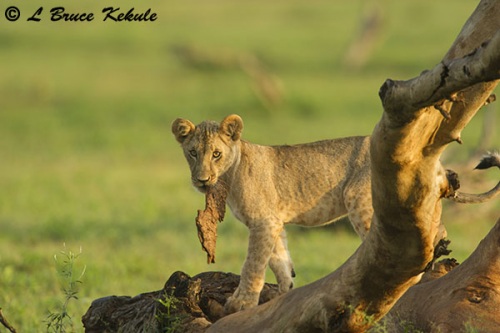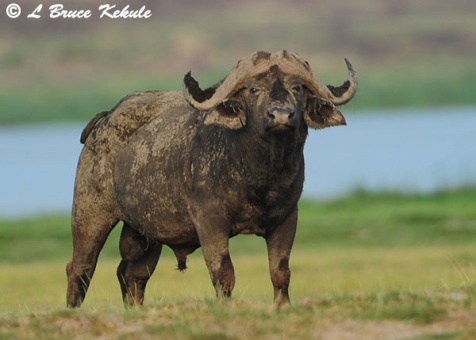Posts Tagged ‘Kenya’s wildlife’
The Big Five: Mega-fauna of the East African savanna
A safari to Kenya’s protected areas photographing the ‘Big Five’
Leopard mother in Samburu National Reserve
As we motored back to the lodge after my last game drive in Kenya’s Samburu National Reserve in December 2012, the feeling of disappointment began to overcome me. With no leopard in the bag, I would not get the so-called ‘Big Five’, which are the most dangerous animals on the African continent made up of elephant, rhino, buffalo, lion and leopard. Of these, it is the leopard that is the most notoriously difficult to obtain and is the secret to a successful safari.
My driver/guide Patrick Njoroge was more optimistic and said, we still had time and as if the ‘Spirits of the Wild’ were listening, a female leopard and her two cubs out in the morning sunshine, suddenly appeared by the side of the road. I immediately began shooting my Nikon medium camera, as they were very close. The action was quick and they then melted into the bush. After the dust settled, a feeling of joy took over me. My dream to get the ‘Big Five’ had come true once again.
In September 2010, I had a great opportunity to visit Kenya and on the very first day, got a leopard in a tree in the Masai Mara National Reserve that guaranteed the ‘Big Five’ was in the bag. I managed to get the other four quite easily.
Lion cub with a piece of bark in Tsavo East National Park
On my next safari in August 2011, a leopard was captured the second day, again in Masai Mara. A mother and her cub were hanging out in a dry streambed eating an antelope carcass. My driver/guide, the late George Ndungu managed to get the vehicle real close and I was able to photograph both of them. The elephant, buffalo, lion and finally the rhino were also collected.
On my third trip in May 2012 to southern Kenya while me and Patrick were out on game drive, he spotted a leopard kill (wild cat and jackal) in a tree by the side of the road. This was amazing in itself, and I decided to set a camera trap in a hollow log on the ground facing up at the kill. The next morning, I netted a single photo of the leopard with the jackal in its mouth. This was in Tsavo East National Park and that was a spooky capture.!
Getting the ‘Big Five’ a forth time in a row this last December was for me a complete stroke of luck. Many photographers and nature lovers who visit the ‘Dark Continent’ strive for the complete group but go home feeling empty-handed without the spotted cat. But then again, others bump into the ‘ghost’ easily. It is all about luck and I feel fortunate to have some, I guess.
Elephant bull in Tsavo West National Park
The term the ‘Big Five’ was coined by colonial hunters in East Africa sometime in the 1850s, and was the trophies collected of the large dangerous mammals all taken with a gun. Photography was in its infant stage and very few photographs of wild animals in the natural habitat were available from the era other than pictures of downed animals with the trophy hunter and gun bearers by its side.
Going on safari was big business just after the beginning of the 20th century, and usually only the well off could afford such a journey. It actually was quite fashionable to visit Africa and bag the ‘Big Five’. They then took the trophies home to show them off to other like-minded hunters.
The safari business was thriving and when many famous people like Theodore Roosevelt and later Hollywood movies stars like Clark Gable, Ava Gardner, Grace Kelly and Stewart Granger really made the business jump.
Cape buffalo bull in Amboseli National Park
But remember, Roosevelt as President helped establish an additional five national parks to the list that already included Yellowstone, Yosemite, Sequoia, General Grant, and Mount Rainier national parks. He doubled the number of national parks to 10 and helped numerous other protected lands get established.
One of the first countries to ban hunting in Africa was Kenya in 1977 whose people and government saw the need and meaning of saving wildlife for generations to come, and as a source of income for the country. Other countries like Tanzania followed suit and now one can go on a photography/viewing safari and see most of the animals that dot the savanna.
Protected areas were quickly designated and the business of safari continued, but because many animals have now come back from the brink of extinction, the efforts of the government has paid-off. Kenya and Tanzania are commended for taking the first brave steps in protecting the environment and its wildlife for the world to see and cherish.
Black rhino female in Nairobi National Park
I am of course addicted to Africa, especially Kenya. They say once you get the bug, it’s hard to stay away. I am planning another safari with my family sometime this year once again with Trans World Safaris in Nairobi. They have proven to be the best safari company for my needs. Their organization, planning and staff are superb.
In the event you take a vacation, I recommend a safari to Kenya. The chances are good that you will see many creatures of nature including the ‘Big Five’. Reasonable costs can be had with a little shopping on the Internet. The choices are broad and a ‘once in a lifetime’ trip is there for the taking. Enjoy!






